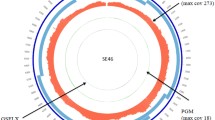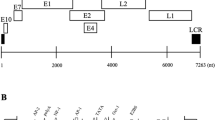Abstract
The present study describes the clinical and pathological characteristics of skin lesions in two four-toed hedgehogs (Atelerix albiventris). We performed inverse PCR to identify the genome of papillomavirus (PV) in the skin lesions and subsequently sequenced the full genome of the virus, which was tentatively named Atelerix albiventris papillomavirus 1 (AalbPV1). The overall sequences of the viral genomes of both four-toed hedgehogs were identical. This study first identified the presence of a novel PV in Japanese four-toed hedgehogs and provided genetic information about this virus.

Similar content being viewed by others
References
Rector A, Van Ranst M (2013) Animal papillomaviruses. Virology 445:213–223. https://doi.org/10.1016/j.virol.2013.05.007
Lunardi M, Alfieri AA, Otonel RAA, de Alcântara BK, Rodrigues WB, de Miranda AB, Alfieri AF (2013) Genetic characterization of a novel bovine papillomavirus member of the Deltapapillomavirus genus. Vet Microbiol 162:207–213. https://doi.org/10.1016/j.vetmic.2012.08.030
Christensen ND, Cladel NM, Reed CA, Han R (2000) Rabbit oral papillomavirus complete genome sequence and immunity following genital infection. Virology 269:451–461. https://doi.org/10.1006/viro.2000.0237
Joh J, Jenson AB, Proctor M, Ingle A, Silva KA, Potter CS et al (2012) Molecular diagnosis of a laboratory mouse papillomavirus (MusPV). Exp Mol Pathol 93:416–421. https://doi.org/10.1016/j.yexmp.2012.07.001
Truchado DA, Moens MA, Callejas S, Pérez-Tris J, Benítez L (2018) Genomic characterization of the first oral avian papillomavirus in a colony of breeding canaries (Serinus canaria). Vet Res Commu 42:111–120
De Villiers EM, Fauquet C, Broker TR, Bernard HU, Zur Hausen H (2004) Classification of papillomaviruses. Virology 324:17–27. https://doi.org/10.1016/j.virol.2004.03.033
Clifford GM, Smith JS, Aguado T, Franceschi S (2003) Comparison of HPV type distribution in high-grade cervical lesions and cervical cancer: a meta-analysis. Br J Cancer 89:101–105. https://doi.org/10.1038/sj.bjc.6601024
Muñoz N, Bosch FX, De Sanjosé S, Herrero R, Castellsagué X, Shah KV et al (2003) Epidemiologic classification of human papillomavirus types associated with cervical cancer. N Engl J Med 348:518–527. https://doi.org/10.1056/NEJMoa021641
Matsukura T, Sugase M (2001) Relationships between 80 human papillomavirus genotypes and different grades of cervical intraepithelial neoplasia: association and causality. Virology 283:139–147. https://doi.org/10.1006/viro.2001.0865
Zur Hausen H (2002) Papillomaviruses and cancer: from basic studies to clinical application. Nat Rev Cancer 2:342–350. https://doi.org/10.1038/nrc798
Grce M, Mravak-Stipetić M (2014) Human papillomavirus–associated diseases. Clin Dermatol 32:253–258. https://doi.org/10.1016/j.clindermatol.2013.10.006
Bocaneti F, Altamura G, Corteggio A, Velescu E, Roperto F, Borzacchiello G (2016) Bovine papillomavirus: new insights into an old disease. Transbound Emerg Dis 63:14–23. https://doi.org/10.1111/tbed.122229
Munday JS, Fairley R, Lowery I (2020) Detection of Ovis aries papillomavirus type 2 DNA sequences in a sarcoid-like mass in the mouth of a pig. Vet Microbiol 248:108801. https://doi.org/10.1016/j.vetmic.2020.108801
Kadaja M, Silla T, Ustav E, Ustav M (2009) Papillomavirus DNA replication—from initiation to genomic instability. Virology 384:360–368. https://doi.org/10.1016/j.virol.2008.11.032
Rosty C, Sheffer M, Tsafrir D, Stransky N, Tsafrir I, Peter M et al (2005) Identification of a proliferation gene cluster associated with HPV E6/E7 expression level and viral DNA load in invasive cervical carcinoma. Oncogene 24:7094–7104. https://doi.org/10.1038/sj.onc.1208854
Zheng ZM, Baker CC (2006) Papillomavirus genome structure, expression, and post-transcriptional regulation. Front Biosci 11:2286–2302. https://doi.org/10.2741/1971
Finnen RL, Erickson KD, Chen XS, Garcea RL (2003) Interactions between papillomavirus L1 and L2 capsid proteins. J Virol 77:4818–4826. https://doi.org/10.1128/jvi.77.8.4818-4826
Villanueva R, Morales-Peza N, Castelán-Sánchez I, García-Villa E, Tapia R, Cid-Arregui A et al (2006) Heparin (GAG-hed) inhibits LCR activity of human papillomavirus type 18 by decreasing AP1 binding [GAG-hed]. BMC Cancer 6:218. https://doi.org/10.1186/1471-2407-6-218
Sichero L, Sobrinho JS, Villa LL (2012) Identification of novel cellular transcription factors that regulate early promoters of human papillomavirus types 18 and 16. J Infect Dis 206:867–874. https://doi.org/10.1093/infdis/jis430
Okada K, Kondo H, Sumi A, Kagawa Y (2018) A retrospective study of disease incidence in African pygmy hedgehogs (Atelerix albiventris). J Vet Med Sci 80:1504–1510. https://doi.org/10.1292/jvms.18-0238
Raymond JT, Garner MM (2001) Spontaneous tumours in captive African hedgehogs (Atelerix albiventris): a retrospective study. J Comp Pathol 124:128–133. https://doi.org/10.1053/jcpa.2000.0441
Okumura N, Koizumi I, Iwata Y, Yoneya S, Koba R, Kondo H, Shibuya H (2021) Cutaneous papilloma and multicentric squamous cell carcinoma in four-toed hedgehogs (Atelerix albiventris). J Vet Med Sci 83:1726–1729. https://doi.org/10.1292/jvms.21-0302
Schulz E, Gottschling M, Bravo IG, Wittstatt U, Stockfleth E, Nindl I (2009) Genomic characterization of the first insectivoran papillomavirus reveals an unusually long, second non-coding region and indicates a close relationship to Betapapillomavirus. J Gen Virol 90:626–633. https://doi.org/10.1099/vir.0.008011-0
Zaugg N, Nespeca G, Hauser B, Ackermann M, Favrot C (2005) Detection of novel papillomaviruses in canine mucosal, cutaneous and in situ squamous cell carcinomas. Vet Dermatol 16:290–298. https://doi.org/10.1111/j.1365-3164.2005.00467.x
Tobler K, Lange C, Carlotti DN, Ackermann M, Favrot C (2008) Detection of a novel papillomavirus in pigmented plaques of four pugs. Vet Dermatol 19:21–25. https://doi.org/10.1111/j.1365-3164.2007.00640.x
Songyang Z, Fanning AS, Fu C, Xu J, Marfatia SM, Chishti AH et al (1997) Recognition of unique carboxyl-terminal motifs by distinct PDZ domains. Science 275:73–77. https://doi.org/10.1126/science.275.5296.73
Ganti K, Broniarczyk J, Manoubi W, Massimi P, Mittal S, Pim D et al (2015) The human papillomavirus E6 PDZ binding motif: from life cycle to malignancy. Viruses 7:3530–3551. https://doi.org/10.3390/v7072785
Helt AM, Galloway DA (2001) Destabilization of the retinoblastoma tumor suppressor by human papillomavirus type 16 E7 is not sufficient to overcome cell cycle arrest in human keratinocytes. J Virol 75:6737–6747. https://doi.org/10.1128/JVI.75.15.6737-6747.2001
Ma T, Zou N, Lin BY, Chow LT, Harper JW (1999) Interaction between cyclin-dependent kinases and human papillomavirus replication-initiation protein E1 is required for efficient viral replication. Proc Natl Acad Sci USA 96:382–387. https://doi.org/10.1073/pnas.96.2.382
Van Doorslaer K, Rector A, Jenson AB, Sundberg JP, Van Ranst M, Ghim SJ (2007) Complete genomic characterization of a murine papillomavirus isolated from papillomatous lesions of a European harvest mouse (Micromys minutus). J Gen Virol 88:1484–1488. https://doi.org/10.1099/vir.0.82615-0
Matys V, Fricke E, Geffers R, Gössling E, Haubrock M, Hehl R et al (2003) TRANSFAC®: transcriptional regulation, from patterns to profiles. Nucleic Acids Res 31:374–378. https://doi.org/10.1093/nar/gkg108
García-Vallvé S, Iglesias-Rozas JR, Alonso A, Bravo IG (2006) Different papillomaviruses have different repertoires of transcription factor binding sites: convergence and divergence in the upstream regulatory region. BMC Evol Biol 6:20. https://doi.org/10.1186/1471-2148-6-20
Acknowledgements
This study was supported by the Academic Frontier Project for Private Universities from the Ministry of Education, Culture, Sports, Science and Technology (MEXT) of Japan.
Author information
Authors and Affiliations
Contributions
Conceived and designed the experiments, YS and RK; Sample collection, YS, SS, and KM; Performed the experiments, YS, SY, TN, and RK; Analyzed the data, YS, SY, SF, KN, TN, NO, HK, KN, and RK; Wrote original draft, KN and RK; Review and Editing, KN, HK, KN, and YT. All authors have read and agreed to the published version of the manuscript.
Corresponding author
Ethics declarations
Conflict of interest
The authors declare that they have no known competing financial interests or personal relationships that could have appeared to influence the work reported in this paper.
Ethical approval
All experimental procedures involving animals were approved by the ethics committee of our institution.
Consent to participate
Written informed consent to animal owners in the study was obtained from individual animal owners before specimen collection.
Additional information
Edited by Takeshi Noda.
Publisher's Note
Springer Nature remains neutral with regard to jurisdictional claims in published maps and institutional affiliations.
Supplementary Information
Below is the link to the electronic supplementary material.
Rights and permissions
Springer Nature or its licensor (e.g. a society or other partner) holds exclusive rights to this article under a publishing agreement with the author(s) or other rightsholder(s); author self-archiving of the accepted manuscript version of this article is solely governed by the terms of such publishing agreement and applicable law.
About this article
Cite this article
Shimazaki, Y., Yoneya, S., Fujita, S. et al. Identification and characterization of the genome of a papillomavirus from skin lesions of four-toed hedgehogs (Atelerix albiventris). Virus Genes 59, 234–239 (2023). https://doi.org/10.1007/s11262-022-01965-x
Received:
Accepted:
Published:
Issue Date:
DOI: https://doi.org/10.1007/s11262-022-01965-x




